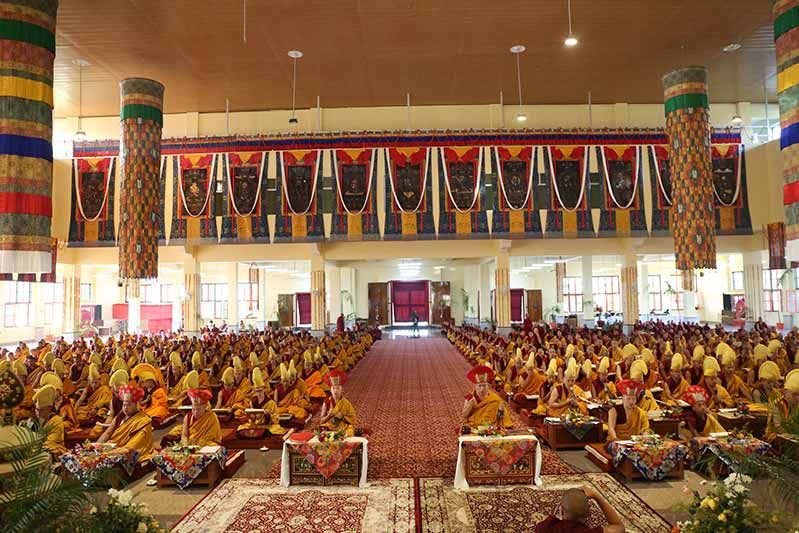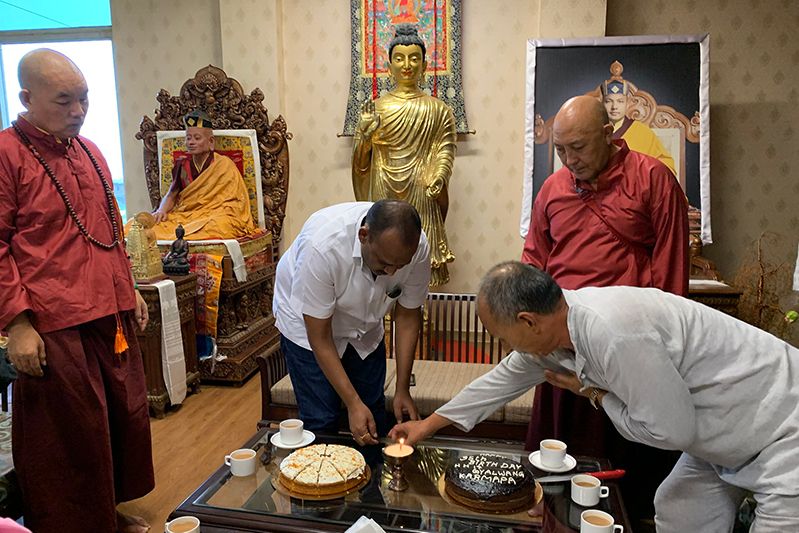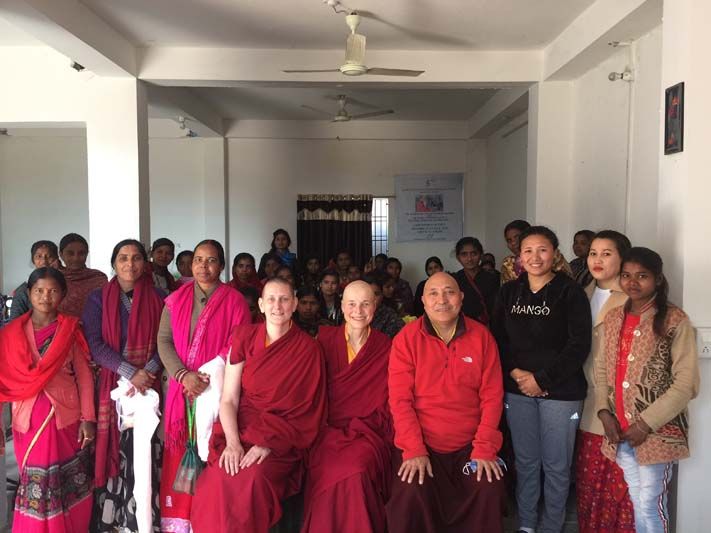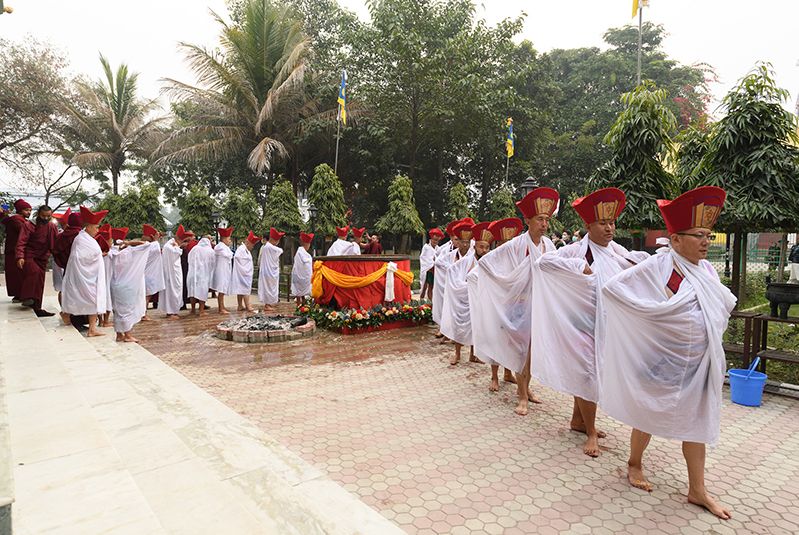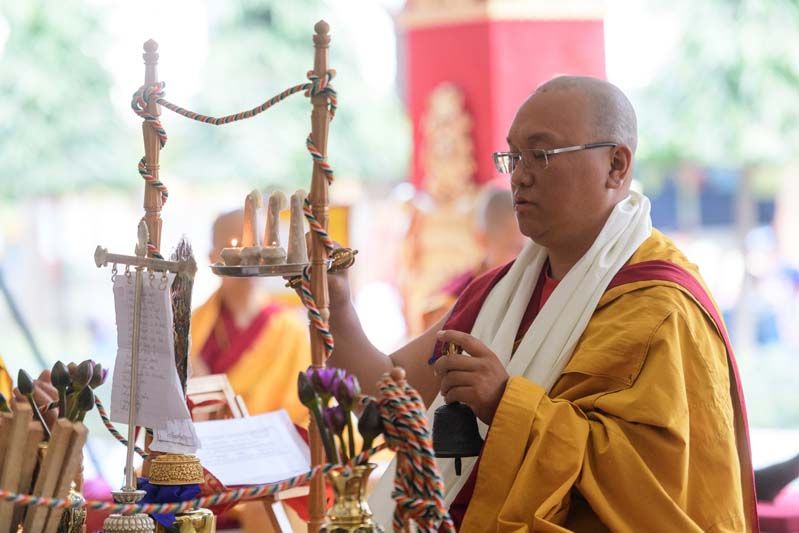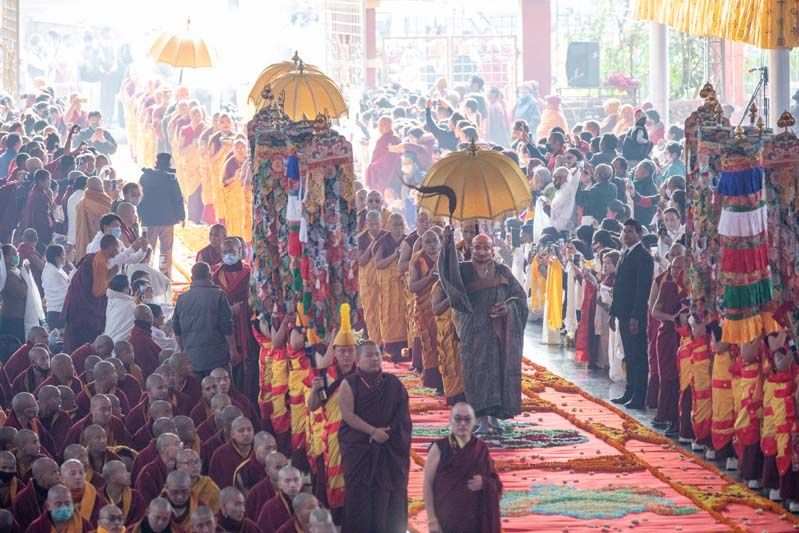“Those of Supreme Fortune”: His Eminence Goshir Gyaltsab Rinpoche Offers the Red Crown Ceremony and Confers an Amitayus Empowerment
- February 9, 2020

Monlam Pavilion, February 9, 2020
On the morning after the conclusion of the 37th Kagyu Monlam, His Eminence Goshir Gyaltsab Rinpoche, one of the Karmapa’s heart sons and the presiding head of this year’s Monlam, offered a Vajra Crown ceremony in accordance with the wishes of His Holiness, the 17th Gyalwang Karmapa. It is an amazing blessing to experience this ritual; vajra crown ceremonies are said to plant seeds of liberation in the minds of all who witness them. The Karmapa is known by his black crown, and over the history of the Kagyu lineage, various incarnations of the Karmapas have bestowed red vajra crowns on their heart sons Situ Rinpoche, Gyaltsab Rinpoche, and Shamar Rinpoche. All of these great beings display their crown periodically for the benefit of faithful students and sentient beings in general. His Eminence Gyaltsab Rinpoche has been especially generous in recent years at the Kagyu Monlam, offering this ceremony in 2017, 2018, and now 2020.
Gyaltsab Rinpoche frequently offers an empowerment along with the Vajra Crown ceremony, and he did so again today, bestowing an Amitayus empowerment which he had received many times from his own root guru, the glorious 16th Karmapa, Rangjung Rigpe Dorje, and which is said to lengthen the lifespans of authentic practitioners.
As everyone knows, and as His Holiness the 17th Karmapa had commented in his audio address to the Monlam the prior afternoon, there is much suffering in the world these days, with the outbreak of the coronavirus in Wuhan, China, and the many weeks of wildfires in Australia which have reportedly left more than 10 million wild animals dead. We practitioners can aspire to meet these difficult times with compassion, and with a firm wish to bring benefit to others. We can train in loving-kindness and bodhicitta, as the buddhas and bodhisattvas did. Receiving powerful blessings from the gurus is further encouragement to do so, and it conveys confidence in the dharma along with their support.
Before the ritual commenced, the official institution of the Gyaltsab Rinpoche lineage, Palchen Choling Labrang, offered a beautiful statement explaining the significance of the Vajra Crown ceremony, and including instructions on how to receive it most purely. This was delivered in three languages, by Khenpo Kelsang Nyima in Tibetan, Khenpo David Karma Choephel in English, and Khenpo Tengye in Mandarin. This teaching on the ceremony is reproduced in full here:
“Om svasti
Embodiment of the wisdom and compassion of all the victors,
Avalokita at the summit of Mount Potala,
The Glorious Karmapa in the Land of Snow,
I prostrate to him whose fame stretches above all like a white parasol.
Vajrapani, the vajra mind of all the victors,
Ananda, the repository of the victor’s teachings,
Regent of the supreme victor Karmapa,
I prostrate at the feet of the great Goshir Gyaltsapa.
On account of their exceptional resolve and aspirations, the buddhas and bodhisattvas engage in inconceivable awakened activity. Among these acts that are meant to be seen and heard, is the ceremonial donning of vajra crowns. These sacred rituals that plant the seed of liberation upon sight, have ripened and liberated countless disciples. This tradition of performing vajra crown ceremonies is particular to the practice lineage of the Karma Kamtsang and is exclusive to the Gyalwang Karmapas and his heart sons.
We find reference to crowns in both the vehicle of characteristics, the sutras, and in the vajra vehicle of the tantras. The sutras recount that before Sakyamuni Buddha appeared in this world, he was residing in the god realm of Tushita, where he was known as Lha’i Bu Dampa Tok Karpo. When departing the god realm for this world, he took his crown and he placed it upon the head of the victor Maitreya, thus empowering him as his regent. It is said that Maitreya currently resides in Tushita performing the first of the twelve deeds of the supreme nirmanakaya – teaching to benefit the gods.
In the secret mantrayana, through the crown empowerment of Ratnasambhava, one is enthroned as a great universal ruler, who lords over the three realms, and is placed upon the great lion throne of the utter victory of non-abiding nirvana, free from the extremes of both conditioned existence and peace.
The Black Crown of the glorious Gyalwang Karmapas was presented to him long ago, when he took birth as the sage, Konpa Kye, on the northern side of Mount Meru. At that time the buddhas empowered him with a crown fashioned of single strands of hair from 320 million dakinis. Beings whose obscurations are thin perceive the Black Crown as ever present above the head of all the incarnations of the Gyalwang Karmapas. But for the benefit of childlike beings ensnared in a thicket of coarse obscurations, a physical Black Crown was fashioned, a symbolic representation of the true crown’s essence, and decorated with various precious gems and a gold blaze.
Each of the Gyalwang Karmapas has heart sons who are actually his emanations. As they are inseparable from him, the Gyalwang Karmapas bestowed upon them vajra crowns and commanded them to accomplish vast benefit for the teachings and beings. Together with his resolve, command of interdependence, and aspirations, the Karmapas enthroned them as Dharma Kings and thus arose the tradition of their vajra crowns.
Goshir Gyaltsab Rinpoche’s red crown originated with a prophecy. The Lotus-born Great Guru Padmasambhava prophesied to the Seventh Gyalwang Karmapa Chödrak Gyatso:
If the agent of the victor’s activity—
The emanation of Karchen Pelgyi Wangchuk
And Dromtön Gyalwe Jungney—
Dons the crown that is the command of the guru,
It will create auspicious conditions
For the Buddha’s teachings to flourish.
Subsequently, a red crown with a golden blaze that liberates upon sight was consecrated through the practice of Lama Gondu. Having been blessed as the essence of vajra speech, Amitabha, it was placed on the head of the 2nd Gyaltsab, Tashi Namgyal. Gyalwang Chödrak Gyamtso then proclaimed that the mind of the teacher and student had become undifferentiated and he thus appointed Gyaltsab Tashi Namgyal as his regent to turn the wheel of dharma. The Karmapa continued, saying that with the Vajra Crown remaining inseparable from the Gyaltsapas, it will create auspicious conditions to sustain all the Buddha’s teachings in general, and in particular, the long-standing tradition that is the essence of the Practice Lineage. He then recited verses, scattering flowers of auspiciousness.
When witnessing the donning of the Vajra Crown, you should have unwavering faith in the support, the Vajra Crown, and focus one-pointedly on this exalted object. At that time and at all times, one should supplicate with devotion while meditating that the lama is the embodiment of all refuges, and situated above your head. You should sustain the mind’s natural state without altering it, and should strive to train in loving kindness, compassion, and bodhichitta. These are the attitudes to hold during the ceremony itself, and also the benefits of witnessing the ritual.
Those who possess black and red crowns, the Gyalwang Karmapas and their heart sons, are the crown jewels of the teachings and beings. By regarding them as the eyes in your forehead and the hearts in your bodies, you should rouse the three faiths: clear faith, (an utterly lucid mind that is not contaminated by any obscuration of selfish attachment or aversion), the faith that longs to truly manifest the ultimate result, and the faith of conviction welling up from the depths of your being. Giving rise to these, you should sustain the nature of mind itself, and train the mind in loving kindness, compassion, and bodhichitta.
The results of making effort in presenting clouds of offerings, in making supplications and forming aspirations when witnessing the vajra crown ceremony are as follows:
Those of supreme fortune will be granted
The qualities of the paths and levels upon beholding it.
For those of lesser fortune who have accumulated many negative actions,
Witnessing the crown ceremony will eradicate misdeeds and obscurations
Accumulated over thousands of kalpas.
The most desirable things of this life will be obtained according to one’s wishes.
By focusing on and supplicating you,
All hopes will be fulfilled accordingly.
Thus, all qualities of meditative experience and realization will arise without difficulty. All negative karma, misdeeds and obscurations will be dispelled. And all your intentions will be accomplished just as you wish.
May the glorious lama’s lotus feet be firm.
May happiness come to all throughout space.
May I and all others gather the accumulations, remove obscurations,
And swiftly be brought to buddhahood.”
In preparation for the crown ceremony and the empowerment, a stately, elegant golden shrine had been erected onstage, with an Amitayus statue in its center and an ornamental screen placed toward the audience. The screen allowed for Gyaltsab Rinpoche to complete the empowerment preliminaries onstage before the ceremony in some privacy, and without distraction.
Once everyone was seated, the gyalings sounded and Gyaltsab Rinpoche ascended his throne. Extensive mandala offerings followed as a long line of sponsors and patrons engaged in the practice of generosity. Rinpoche looked regal on the throne; he wore the Gampopa hat and a golden silk robe, on top of which was draped the richly embroidered, golden brocade cloak worn by high lamas on special dharma occasions.
Especially notable features of the ceremony were the repeated and extensive occurrence of mandala offerings, and also the meditative and deliberate order in which Rinpoche proceeded with the crown blessing. Three times, the shrine master made a mandala offering to Rinpoche as the assembly chanted and held the offering mudra; and each time, Rinpoche responded. First, as the gyalings sounded, he removed the Gampopa hat, handing it to an attendant holding a silken cloth with which to receive it. Then, he opened the large brocaded box holding the crown, and lifted out a red roll of silk, uncovering a crystal mala. Next, he lifted the crown, wrapped in a beautiful green and gold silk cloth, from the box, unwrapping it with care. He seemed to examine the crown, almost as if in wonder, before slowly placing it on his head, steadying it with the right hand, while his left hand turned the mala. The gyalings sounded as Rinpoche, deep in meditation, seeming to regard all beings within his compassion, sat motionless on the shrine. Then, after some time, having completed his mantras, he returned the precious crown to its protective cloth and box, carefully put away the mala, reached for the Gampopa hat and slowly arranged it on his head, and put the brocade cloak around his shoulders.
After displaying the red crown three times, when all in attendance had been given the chance to make extensive mental offerings and aspiration prayers, Rinpoche moved on to the empowerment. He briefly explained the background for this long life empowerment of Buddha Amitayus. First, Rinpoche commented that we who practice the dharma pray for a long lifespan because we need time in order to fulfill our aspirations to benefit sentient beings. Rinpoche noted that living a long life is mainly the result of previous virtue. According to the sutra tradition, Rinpoche said, when people first appeared in the world, they lived for a very long time, and the ten non-virtuous actions were not widespread. Over time, though, as non-virtue has grown, human lifespans have shrunk accordingly. He added that the sutras make the prediction that in the future, the Buddha Maitreya will appear and teach people how to give up non-virtue. Then, the lifespans of people will grow accordingly. Rinpoche took this opportunity to encourage people to give up eating meat and to engage in life release practices. He commented that those who do eat meat should avoid killing wild animals in particular. It is good to offer food and water to hungry and thirsty animals. Such actions will lengthen our lives, as will building statues and stupas.
Rinpoche noted that we can also engage in long-life practices, such as White Tara and Amitayus; but he cautioned that we still need to accumulate the causes and conditions for a long life. Thus, engaging in virtue is still crucial. We need to cultivate good intentions and regard all beings with kindness and compassion, refraining from criticizing or judging them harshly. When we see others of an elevated position, we should rejoice in their virtue without even a hint of envy.
Regarding the empowerment’s genesis, Rinpoche explained that Marpa, the great translator and one of the fathers of the Kagyu lineage, commented to his student, Milarepa, that although he had spent many years gathering dharma teachings in India, returning with many pith instructions, there were some he hadn’t managed to obtain due to timing and circumstances. It would be good if Milarepa could send a student to India to bring back these additional instructions. Milarepa did indeed send one of his most promising students, Rechungpa, to India, in order to receive treatment for an infection from a powerful naga (a water-dwelling spirit). Rechungpa met a guru, Wana, who taught him Vajrapani practice, allowing him to cure his illness. From another guru, Tibupa, Rechungpa then learned the Six Yogas. Finally, he received this Amitayus empowerment from Machig Drupkyi Gyalmo, the Single Mother, Queen of Accomplishment, who had the pith instructions for long life. Rechungpa had been warned that he would not live long, but due to this empowerment, he was able to live to 88. When Rechungpa returned to Tibet, he offered this empowerment to his guru, Milarepa, and it became one of the conditions that allowed Milarepa to have a long life. From there, the blessings of this empowerment spread through the Kagyu lineage and into other lineages as well.
Rinpoche conferred the empowerment substances personally on several of the rinpoches, as well as on the morning’s guest of honor, the State of Sikkim’s minister of Religion and Rural Development, Sonam Lama. A group of monks then distributed the empowerment substances among the assembly.
Rinpoche’s generosity in bestowing the vajra crown ceremony and this Amitayus empowerment, along with plenty of context and explanation so that devotees could understand the profound nature of what they were receiving, was a wonderful way to end this Monlam. It was a powerful example of the many ways in which our precious teachers care for us, that we may in time grow to resemble them, and in turn, care for others. In particular, the love and care of the 16th and 17th Karmapas and their heart sons continue to bless and uphold our lineage. We are truly fortunate to share a connection with them.


37th Kagyu Monlam Schedule
Tibetan / English / Chinese • French • German • Indonesian • Korean • Polish • Russian • Spanish • Vietnamese
Dharma Teachings
 Meditation Instructions
Meditation Instructions
Recorded during the 37th Kagyu Monlam, Bodhgaya, India. January 28-30, 2020.
